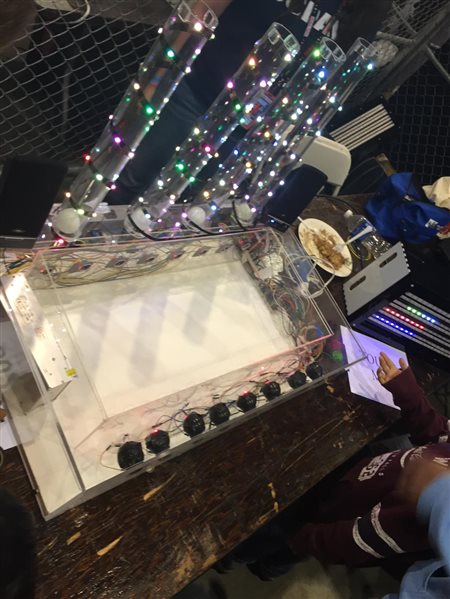As we’ve said before, we saw tons of innovative electronics projects at Maker Faire Bay Area this year. One of our favorite things to do at the show every year is explore the rows upon rows of booths for projects that include TI parts to see the creative ways people use our products. This year we stopped by the University of California (UC), Davis booth to find students using the TM4C123G LaunchPad in their Laser Piano.
 A group of students that goes by the name Project Bravo developed the Laser Piano as part of a junior design project class called EE Emerge at UC Davis. The Laser Piano features eight lasers aimed at laser sensors. When you interrupt the lasers with your hand, a note that corresponds to that laser sounds. For the sounds, each of the eight notes corresponds to the eight tones of a B major scale from low B to high B. Every two lasers also correspond to one of four fans that blow a ball up a tube when one of those notes is played.
A group of students that goes by the name Project Bravo developed the Laser Piano as part of a junior design project class called EE Emerge at UC Davis. The Laser Piano features eight lasers aimed at laser sensors. When you interrupt the lasers with your hand, a note that corresponds to that laser sounds. For the sounds, each of the eight notes corresponds to the eight tones of a B major scale from low B to high B. Every two lasers also correspond to one of four fans that blow a ball up a tube when one of those notes is played.
To create the electronic instrument, the students used the TM4C123G LaunchPad to control the music, LEDs, sensors and blowers. The wide range of GPIO pins on the TM4C LaunchPad allowed the students to have enough pins for all of their separate peripherals. The students took advantage of Energia software to make programming more simple. The LM317 linear regulator (LDO) was used for their laser PCBs. For the laser diodes, they needed a steady current source. By placing a resistor between the adjust and output pins, they were able to create a current source out of the LM317. The PCF8574 input/output (I/O) expander was used to connect the sensors to the microcontroller using I2C communication. The component allowed the students to read in the values of the light sensors all at once, whether they were on or off.
Because the students each worked on separate pieces of the project, the biggest challenge they faced during development was the physical integration of each component. “Making everything work together simultaneously was a challenge because some components would work perfectly individually, but not when combined. We had to become really good at debugging and locating issues as well as coming up with solutions to solve the problems,” said Ryan Marquiss, one of the members of Project Bravo that showed off the final project at Maker Faire.
Next up for Project Bravo is their senior design project, where they will focus on creating an electronics project for a local company.
Want to start developing your own project with LaunchPad?
- Buy the TM4C123G LaunchPad at the TI store
- Join our hobbyist mailing list
